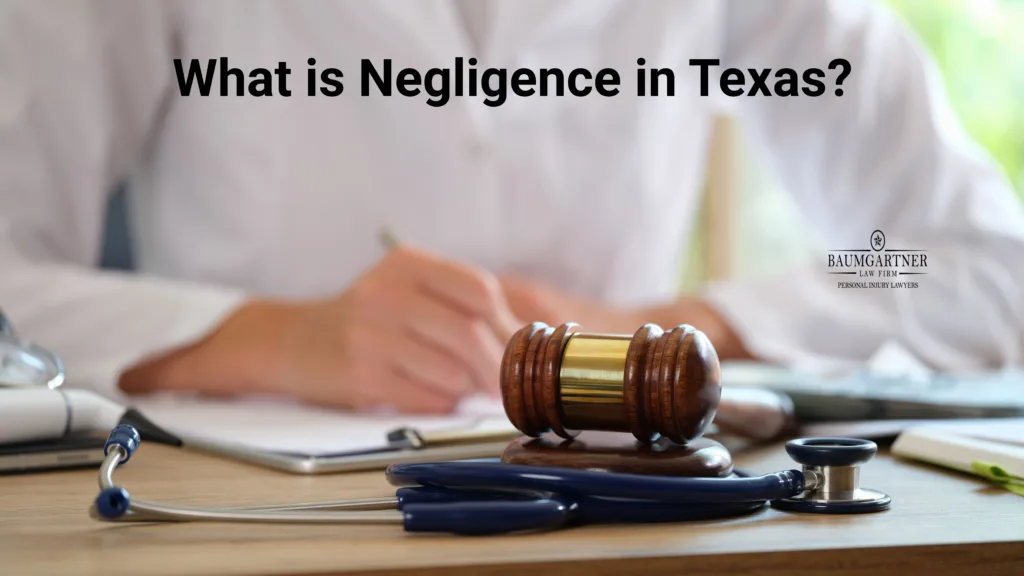
According to the National Safety Council (NSC), the top three causes of preventable injury are falls, auto accidents, and poisoning. These preventable accidents may not have happened if motorists, property owners, and private companies had been more careful.
Not doing these basic duties can lead to injuries that greatly change the lives of victims and their families. Civil courts in Texas sum up this issue with one word: “Negligence.” But what exactly is negligence, and how does it affect your personal injury lawsuit? How do you prove that someone else’s negligence led to your injuries?
We explain everything you need to know about negligence, including its role in Texas injury lawsuits. If you were injured due to negligence, contact a knowledgeable personal injury lawyer in Houston. They can assist you in discussing the circumstances surrounding your injuries. A skilled lawyer can help you understand your legal options and seek compensation for your damages.
Contacting a lawyer is important when addressing negligence-related injuries. Contact Baumgartner Law Firm online to schedule a free consultation today.
Ready to secure the compensation you deserve? Baumgartner Law Firm in Houston is trusted with over 35 years of experience and many multi-million dollar wins. Call our law office at (281) 587-1111 to get started.
Defining Negligence in Personal Injury Claims
Negligence is the failure to act responsibly and safely toward other people. A negligent individual exhibits behavior that puts others in direct danger and can take action or inaction. The failure to act can be just as harmful as reckless, irresponsible actions.
Negligent behavior can occur in various entities, including individuals, private companies, and government agencies. Texas courts decide if someone was negligent by asking if a “reasonable person” would have acted the same way.
Finally, someone can never be “guilty” of negligence – guilt only applies to criminal cases. Civil courts can hold a negligent party responsible for damages by making them pay for the harm they caused.
In most personal injury cases, you must establish negligence to pursue compensation for your damages. If you have a car accident in Texas, you must show that someone else is at fault to receive compensation for your injuries.
You must demonstrate that another person’s actions or negligence led to the accident. Without this proof, you may be unable to recover damages for your medical expenses or other losses. Gathering evidence and documentation to support your claim to successfully seek compensation is important. The same logic applies to many other personal injury cases, including slip-and-fall lawsuits.
The Four Elements of Negligence in Texas
Negligence is a specific legal concept, and establishing it can be complex — especially without expert legal assistance. Your attorney must establish four crucial elements to demonstrate the defendant’s negligence.
1. Duty of Care
First, the plaintiff must show that the defendant owed them a “duty of care.” In simpler terms, the defendant should have been careful towards the plaintiff, considering their circumstances.
In the case of an auto accident, all drivers become responsible for the safety of others when they receive their licenses. When driving, follow the rules and drive safely to protect others on the road. This relationship may be more specific in other situations.
For example, a landlord must provide tenants with a safe, hygienic space that adheres to fire safety laws. A truck driver must follow the safety regulations to prevent a trucking accident. A property owner must clean up spills and address walking hazards in a timely manner. The specific nature of this duty of care varies depending on the circumstances of each personal injury lawsuit.
2. Breach of Duty
Once the plaintiff establishes a duty of care, they must show that the defendant breached the duty. In other words, the defendant failed to act reasonably and responsibly. Courts must decide if the defendant should have been more careful and responsible based on how a reasonable person would act. Some breaches of duty are clear, like drinking and driving. But other breaches, like merging onto a highway incorrectly, may be less obvious. Breaches may also occur through inaction, such as failing to fix a broken set of stairs.
It is important to consider the concept of “awareness” when assessing a potential breach of duty. If someone was unaware of a particular hazard, the court may not reasonably expect them to address it. For example, a customer might spill milk on the floor of a grocery store. Thirty seconds later, another customer might walk by and slip. The store owner may argue that they didn’t have enough time to notice the spill and clean it up. The court can decide that a person should have known about a danger, even if the defendant says they didn’t know.
3. Causation
Causation is another important element of negligence in Texas. It represents the link between the breach of duty and the plaintiff’s injuries. In some cases, a defendant may have exhibited negligence, but their behavior may not have directly caused an injury.
A grocery store owner saw spilled milk in the frozen foods section. They didn’t clean it up for hours. They knew it was dangerous. This is an obvious form of negligence – but what if a shopper slips and falls in a completely different aisle where no hazard exists? In this case, there would be no causational link between the negligent behavior and the injury.
4. Damages
Finally, plaintiffs must prove they have experienced legitimate damages due to the negligence. These damages can be economic or non-economic. Proving damages can be straightforward in certain situations. This can be done by presenting medical records, hospital bills, and X-rays.
These documents serve as evidence of actual injuries sustained. In other cases, the plaintiff may call a doctor to testify about the injuries and how the accident caused them. They may also provide income statements and tax returns to establish the cost of their missed wages.
Read More: How To Prove Wrongful Death in Texas?
Defenses Against Negligence
Several defenses can be used to counter a case of negligence:
Contributory Negligence: The defendant argues that the plaintiff’s own negligence contributed to their injury.
Comparative Negligence: The plaintiff’s recovery is reduced by the percentage of their fault.
Assumption of Risk: The plaintiff knowingly and voluntarily assumed the risk of harm.
Statute of Limitations: The plaintiff filed the lawsuit after the legally allowed time period.
The Role of Comparative Negligence in Texas
Comparative negligence allows for the apportionment of fault between parties. In Texas, the amount of compensation a plaintiff receives is determined by their level of fault. This is because Texas follows comparative negligence rules. If a plaintiff is found to be partially at fault for an incident, their compensation will be reduced accordingly. The more at fault the plaintiff is, the less compensation they will receive. For example, if a plaintiff is found to be 30% at fault, their damages award will be reduced by 30%.
In Texas, an injured person can only get money if they are found to be less than 51% at fault.
Importance of Legal Representation
Navigating a negligence case can be complex and requires a thorough understanding of legal principles and evidence gathering. Experienced attorneys play a crucial role in:
Assessing Case Strength: Evaluating the viability of a prima facie negligence claim.
Collecting Evidence: Gathering and preserving necessary evidence to support the claim.
Negotiating Settlements: Engaging in settlement negotiations to potentially avoid a lengthy trial.
Representing in Court: Advocating on behalf of the plaintiff during trial proceedings.
Baumgartner Law Firm: Experienced Texas Personal Injury Lawyers in Houston
Internet research can give a basic idea of negligence in Texas, but an online article has limitations. Each personal injury case may involve different types of negligence that may not be immediately clear. Establishing various forms of negligence requires convincing evidence, proven investigative techniques, and extensive knowledge of personal injury law in Texas.
Work with the Baumgartner Law Firm, and you can carry out all these steps confidently. Established in 1985, this law firm has assisted injured plaintiffs in Texas for over 35 years. Schedule a meeting to discuss a plan that fits your situation. Focus on the type of negligence that led to your injuries.
We offer a free consultation- Call us at (281) 587-1111.
Baumgartner Law Firm
6711 Cypress Creek Pkwy, Houston, TX, 77069
(281) 587-1111
Related Resources:
About Our Law Firm
Baumgartner Law Firm is a Houston personal injury law firm headed by Greg Baumgartner.
Our firm was established in 1985 and has helped thousands of injury victims get maximum compensation for their cases. If you have been injured in an accident in Houston, TX, contact us for a free, no-obligation consultation. (281) 587-1111.
Since 1985, Baumgartner Law Firm has limited our law practice to serious personal injury cases. Our legal team has won maximum compensation for thousands of accident victims and recovered millions of dollars for real people like you. The practice areas we focus on are the following:
· Auto & Car Accidents
· Catastrophic and Severe Injuries
· Construction Site Accidents
· Daycare Negligence & Child Injury
· Dram Shop Lawsuits
· Drunk Driving Accidents
· Lyft Accidents
· Motorcycle Accidents
· Personal Injury
· Truck Accidents
· Uber Accidents
· Work Injury
· Wrongful Death
Helping these areas around Houston
Houston, Sugar Land, Conroe, The Woodlands, Cypress, Spring, Humble, Katy, Atascocita, Kingwood and Tomball.

